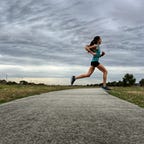Running, Meet Pilates
How the merging of these two contrasting movement modalities builds injury resiliency, mental toughness and the ability to keep grinding.
Twenty years ago, as a project for my middle school PE class, I started running. The challenge was simply to do some type of “fitness” activity every day. I left the house wearing whatever pair of shoes I already had and my obnoxiously bold coloured cotton leggings. I had a selection of long sleeve cotton shirts that I would layer underneath a fleece if it was winter, and then a fleece vest that I would wear on top. Some of the clothes, I still wore to school the next day. From the first time I started to run, I only ever set out to cover a small distance. And when it got easier and I felt like it, I increased it and went further. That first five-kilometre day was the foundation of something bigger than I knew.
And I think it was exactly because I didn’t know that I kept going. I didn’t think about being fast or doing any warm up. I didn’t bother with stretching (still don’t really), and I certainly wasn’t getting caught up in the hype over certain clothes, shoes or singlets.
Some of those things have changed, of course. I now know that cotton is not my friend, that having different running shoes for different terrains, paces and places can make a difference, and I’m chasing big goals in times. But what I didn’t realize would need to change, is that at some point, I would need to start giving back to my body instead of only taking from it. That at some point, I wouldn’t be able to run as easily every day, and that this relentless pounding and pacing and draining mental toughness would be unforgiving if I didn’t learn how to refill the cup.
For a while it was unforgiving. I can think back to low periods in my running journey, where very run was hard, I hated going out the door and willed each foot in front of the other until it was over. I can think back to lower times still, where I spent half of my marathon training cycle on a bike, thanks to an injury in my left foot, relentless and persistent in keeping me off the roads.
I love running. I’ll take cardio exercise over anything else, any day. Until I found Pilates. It was the yin to my running yang, and the untapped potential it held as a tool to help with my running and to increase injury resiliency was huge. I attended classes, took a weekend course, became a teacher; started teaching, got my diploma, studied clinically, taught some more; learned more, taught more, experienced more, taught more. And through it all, every day, I could see how massively beneficial my own Pilates practice was to my running.
Pilates gets this image of being a bit woo woo or hippie dippie — like yoga, but just by a different name. When someone learns I am a Pilates teacher, their response is often, “Oh Pilates! That’s kind of like yoga, right?”
Kind of. But not really. It’s founded on different principles, built on different foundations, and designed for different reasons. In fact, Pilates is more of a rehabilitation movement modality. It is designed to help decrease pain, improve function and efficiency of the body, and teach you how to connect mind body and breath.
This is why, in the context of running, Pilates is a goldmine. Imagine if you could do exercises and movements that not only offered increases in strength, but also addressed the root cause of biomechanical issues, to decrease your chance of getting injured. Imagine if you could do exercises that helped you learn how to connect with your body and embrace pain, instead of turning away and succumbing to it when you hit the pivotal point of a run. Like mile 24 of a marathon.
I can’t make this stuff up. I’m not trying to sell you anything; sales is certainly not my forte (I’d rather just run!). Really, all I’m trying to do is disseminate the knowledge and education around Pilates — what it is, how it works and why it helps. And equally as much, to try to help people get away from these promised quick fix solutions that fail to deliver, or the misguided beliefs that “I just have to rest,” or “I just have to stretch” is the answer to fixing a running injury. Maybe. But it would probably just be luck, or the pain would come back with a vengeance a few days or weeks later.
The research is clear on loading protocols for rehabilitation and correct movement and strengthening as the antidote to reducing injuries. And as runners, our own personal research is clear on the need to maximize the mental game. But you’re not alone if you don’t know how to do it or are tired of everything coming up empty when you try it out.
Go find Pilates. You can do a class online, you can research a studio and attend a class, you can find someone doing it on YouTube and follow along. You can reach out to me if you need somewhere to start (or still aren’t convinced as to why you should). Give it a chance. Put aside all your stories and pre-conceived ideas of what it is and who it is for, and believe that it is something that can help you. Maybe it can. And maybe you will be running again.
You just read another post from In Fitness And In Health: a health and fitness community dedicated to sharing knowledge, lessons, and suggestions to living happier, healthier lives.
If you’d like to join our newsletter and receive more stories like this one, tap here.
